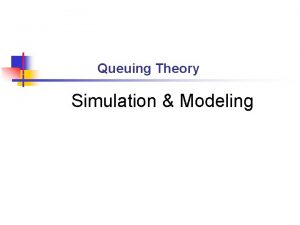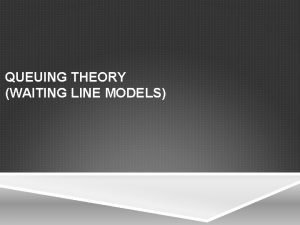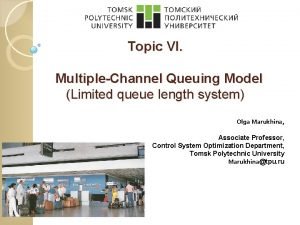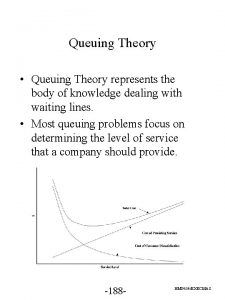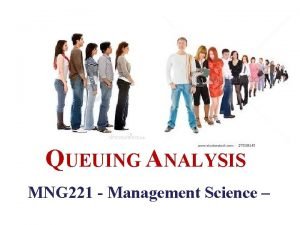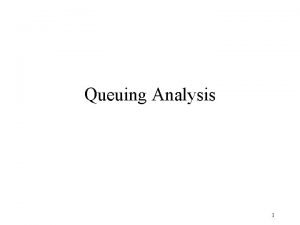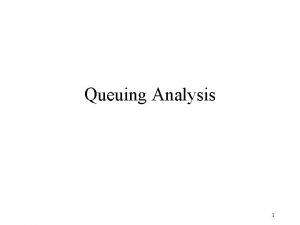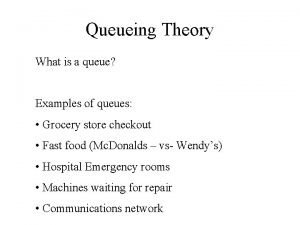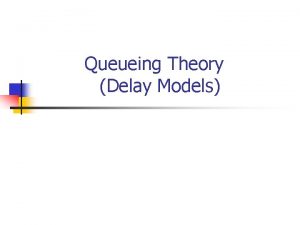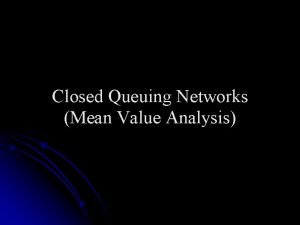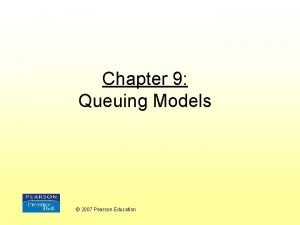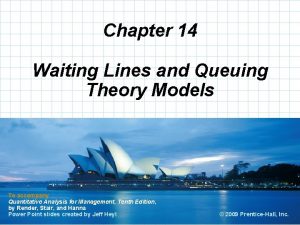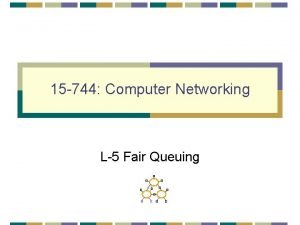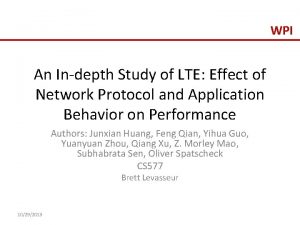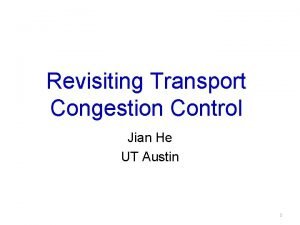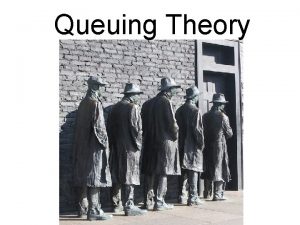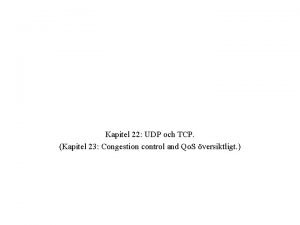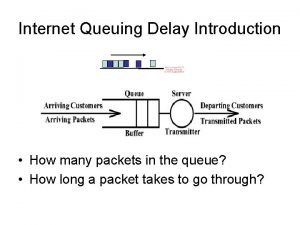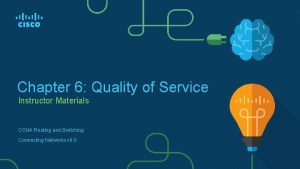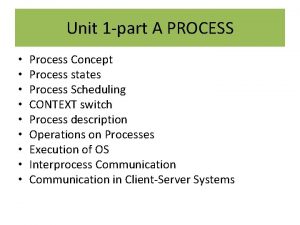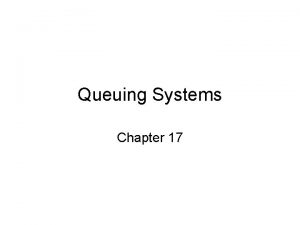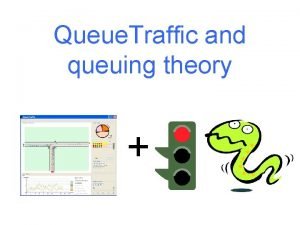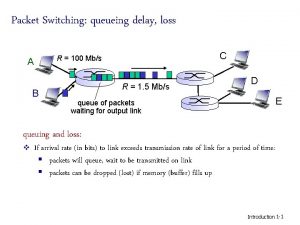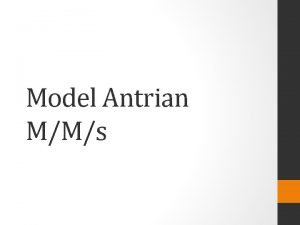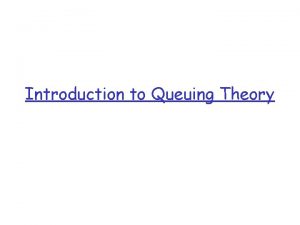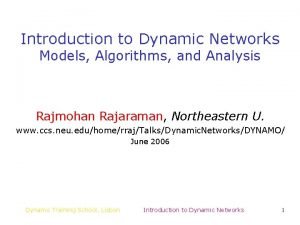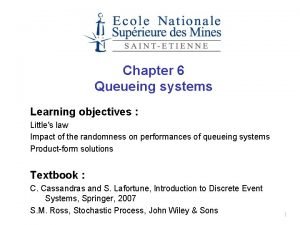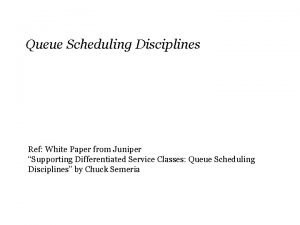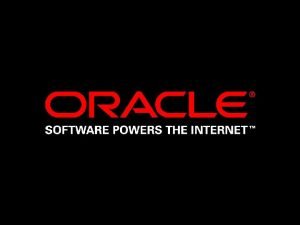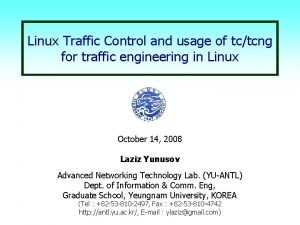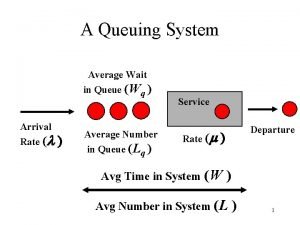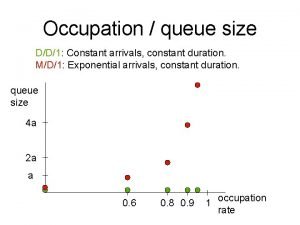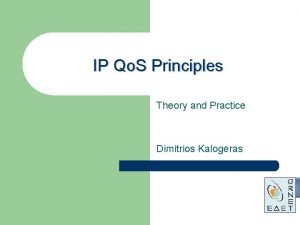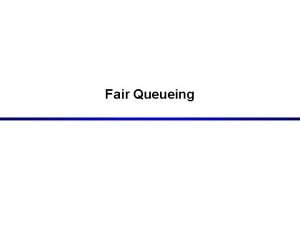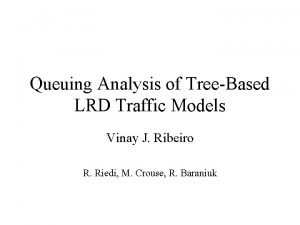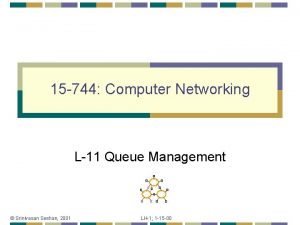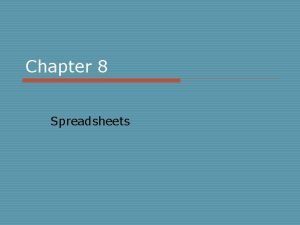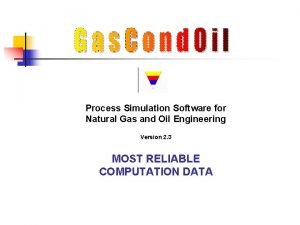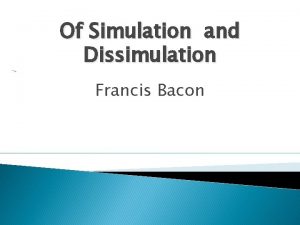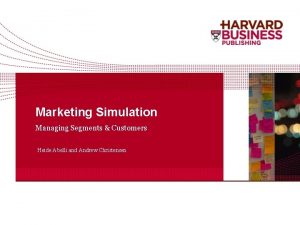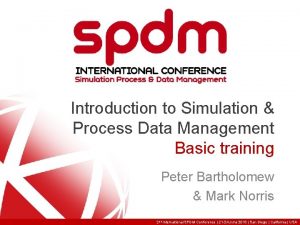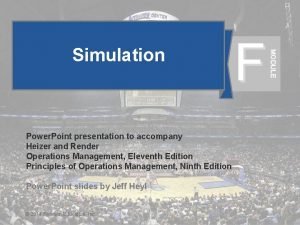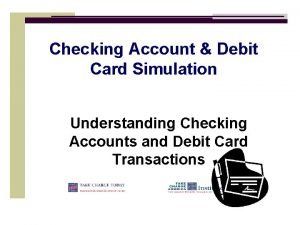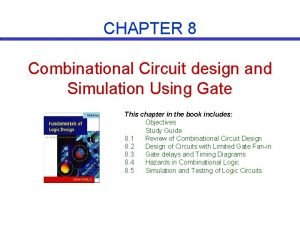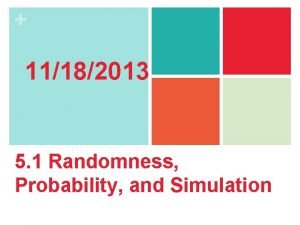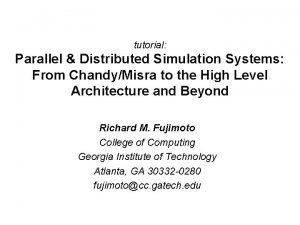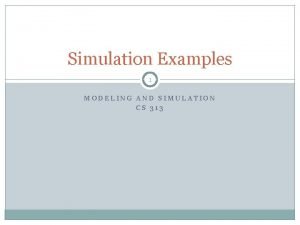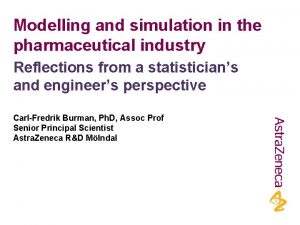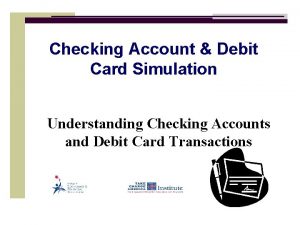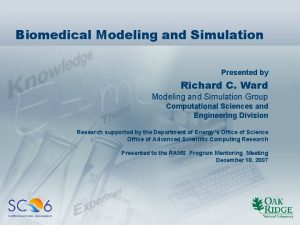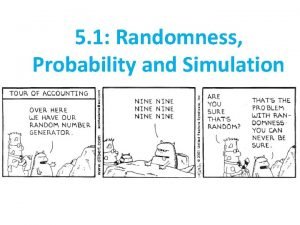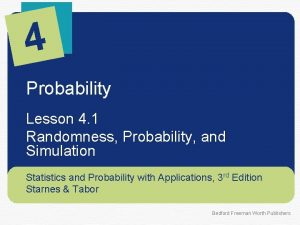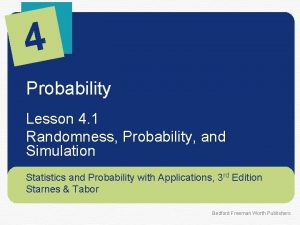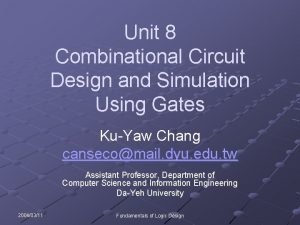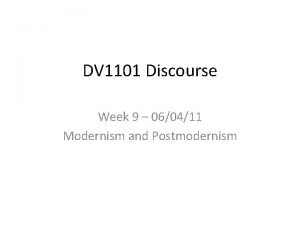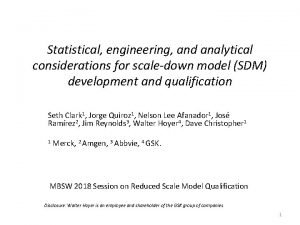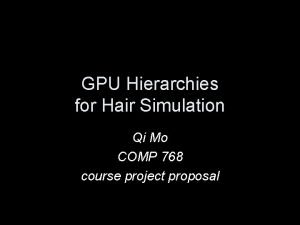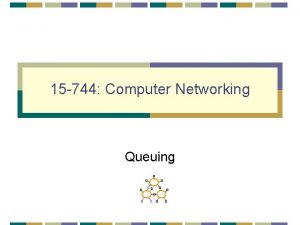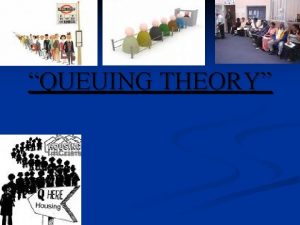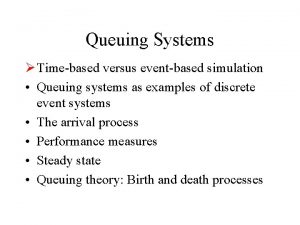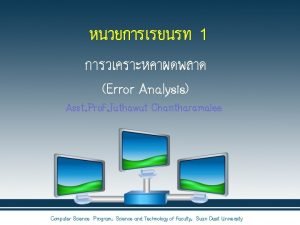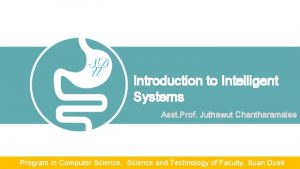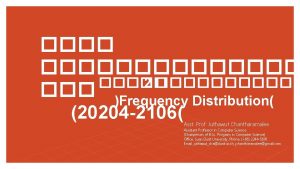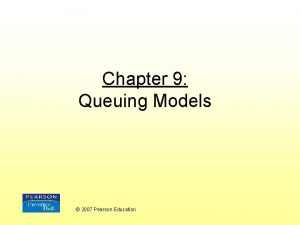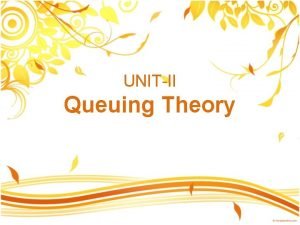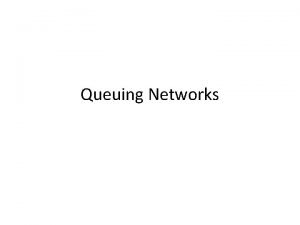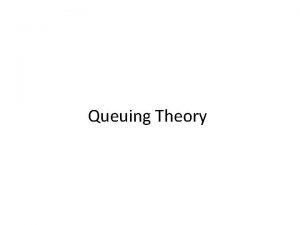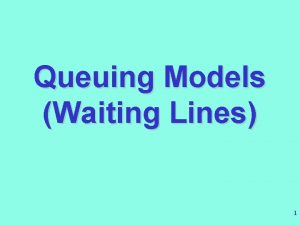Chapter 8 Queuing and Juthawut Simulation Asst Prof


















![The Exponential Distribution f. T(t) Probability density SDUCOMSCI t Mean= E[T] =1/ Time between The Exponential Distribution f. T(t) Probability density SDUCOMSCI t Mean= E[T] =1/ Time between](https://slidetodoc.com/presentation_image_h/2ea80f022e5a465d8bffd770f40eaa0d/image-19.jpg)



















































- Slides: 70

Chapter 8 การเขาแถวคอยและการ จาล อง Queuing and. Juthawut Simulation Asst. Prof. Chantharamalee Program in Computer Science, Science and Technology of Faculty, Suan Dusit

Overview (I) • What is queuing/ queuing theory? – Why is it an important tool? – Examples of different queuing systems • Components of a queuing system • The exponential distribution & queuing • Stochastic processes – Some definitions – The Poisson process • Terminology and notation • Little’s formula • Birth and Death Processes 2

Overview (II) • Important queuing models with FIFO discipline – – The M/M/1 model The M/M/c/K model (limited queuing capacity) The M/M/c/ /N model (limited calling population) • Priority-discipline queuing models • Application of Queuing Theory to system design and decision making 3

Overview (III) • Simulation – What is that? – Why is it an important tool? • Building a simulation model – Discrete event simulation • Structure of a BPD simulation project • Model verification and validation • Example – Simulation of a M/M/1 Queue 4

What is Queuing Theory? • Mathematical analysis of queues and waiting times in stochastic systems. – Used extensively to analyze production and service processes exhibiting random variability in market demand (arrival times) and service times. • Queues arise when the short term demand for service exceeds the capacity – Most often caused by random variation in service times and the times between customer arrivals. 5

Why is Queuing Analysis Important? • Capacity problems are very common in industry and one of the main drivers of process redesign – Need to balance the cost of increased capacity against the gains of increased productivity and service • Queuing and waiting time analysis is particularly important in service systems – Large costs of waiting and of lost sales due to waiting Prototype Example – ER at County Hospital • Patients arrive by ambulance or by their own accord • One doctor is always on duty • More and more patients seeks help longer waiting times 6

Cost A Cost/Capacity Tradeoff Model Total cost Cost of service Cost of waiting Process capacity 7

Examples of Real World Queuing Systems? • Commercial Queuing Systems – Commercial organizations serving external customers – Ex. Dentist, bank, ATM, gas stations, plumber, garage … • Transportation service systems – Vehicles are customers or servers – Ex. Vehicles waiting at toll stations and traffic lights, trucks or ships waiting to be loaded, taxi cabs, fire engines, elevators, buses … • Business-internal service systems – Customers receiving service are internal to the organization providing the service – Ex. Inspection stations, conveyor belts, computer support … • Social service systems 8

Components of a Basic Queuing Process Input Source Calling Population The Queuing System Jobs Queue Arrival Process Queue Configuration Service Mechanism Queue Discipline Served Jobs leave the system Service Process 9

Components of a Basic Queuing Process (II) v The calling population – The population from which customers/jobs originate – The size can be finite or infinite (the latter is most common) – Can be homogeneous (only one type of customers/ jobs) or heterogeneous (several different kinds of customers/jobs) v The Arrival Process – Determines how, when and where customer/jobs arrive to the system – Important characteristic is the customers’/jobs’ interarrival times 10

Components of a Basic Queuing Process (III) v The queue configuration – Specifies the number of queues • Single or multiple lines to a number of service stations – Their location – Their effect on customer behavior • Balking and reneging – Their maximum size (# of jobs the queue can hold) • Distinction between infinite and finite capacity 11

Example – Two Queue Configurations Multiple Queues Servers Single Queue Servers 12

Multiple v. s. Single Customer Queue Configuration Multiple Line Advantages 1. The service provided can be differentiated – Ex. Supermarket express lanes 2. Labor specialization possible 3. Customer has more flexibility 4. Balking behavior may be deterred – Several medium-length lines are less intimidating than one very long line Single Line Advantages 1. Guarantees fairness – FIFO applied to all arrivals 2. No customer anxiety regarding choice of queue 3. Avoids “cutting in” problems 4. The most efficient set up for minimizing time in the queue 5. Jockeying (line switching) is avoided 13

Components of a Basic Queuing Process (IV) v The Service Mechanism – Can involve one or several service facilities with one or several parallel service channels (servers) - Specification is required – The service provided by a server is characterized by its service time • Specification is required and typically involves data gathering and statistical analysis. • Most analytical queuing models are based on the assumption of exponentially distributed service times, with some generalizations. v The queue discipline – Specifies the order by which jobs in the queue are being served. – Most commonly used principle is FIFO. – Other rules are, for example, LIFO, SPT, EDD… 1

Mitigating Effects of Long Queues 1. Concealing the queue from arriving customers – Ex. Restaurants divert people to the bar or use pagers, amusement parks require people to buy tickets outside the park, banks broadcast news on TV at various stations along the queue, casinos snake night club queues through slot machine areas. 2. Use the customer as a resource – Ex. Patient filling out medical history form while waiting for physician 3. Making the customer’s wait comfortable and distracting their attention – Ex. Complementary drinks at restaurants, computer games, internet stations, food courts, shops, etc. at airports 4. Explain reason for the wait 5. Provide pessimistic estimates of the remaining wait time – Wait seems shorter if a time estimate is given. 6. Be fair and open about the queuing disciplines used 1

A Commonly Seen Queuing Model (I) The Queuing System The Service Facility C S = Server Customers (C) The Queue CCC…C C S • • • Customer =C C S 16

A Commonly Seen Queuing Model (II) • Service times as well as interarrival times are assumed independent and identically distributed – If not otherwise specified • Commonly used notation principle: A/B/C – A = The interarrival time distribution – B = The service time distribution – C = The number of parallel servers • Commonly used distributions – M = Markovian (exponential) - Memoryless – D = Deterministic distribution – G = General distribution • Example: M/M/c – Queuing system with exponentially distributed service and inter-arrival 17 times and c servers

The Exponential Distribution and Queuing • The most commonly used queuing models are based on the assumption of exponentially distributed service times and interarrival times. Definition: A stochastic (or random) variable T exp( ), i. e. , is exponentially distributed with parameter , if its frequency function is: The Cumulative Distribution Function is: The mean = E[T] = 1/ The Variance = Var[T] = 1/ 2 18
![The Exponential Distribution f Tt Probability density SDUCOMSCI t Mean ET 1 Time between The Exponential Distribution f. T(t) Probability density SDUCOMSCI t Mean= E[T] =1/ Time between](https://slidetodoc.com/presentation_image_h/2ea80f022e5a465d8bffd770f40eaa0d/image-19.jpg)
The Exponential Distribution f. T(t) Probability density SDUCOMSCI t Mean= E[T] =1/ Time between arrivals 1

Properties of the Exp-distribution (I) v Property 1: f. T(t) is strictly decreasing in t P(0 T t) > P(t T t+ t) for all t, t 0 Ø Implications – Many realizations of T (i. e. , values of t) will be small; between zero and the mean – Not suitable for describing the service time of standardized operations when all times should be centered around the mean • Ex. Machine processing time in manufacturing – Often reasonable in service situations when different customers require different types of service – Often a reasonable description of the time between 20

Properties of the Exp-distribution (II) v Property 2: Lack of memory P(T>t+ t | T>t) = P(T > t) for all t, t 0 Ø Implications – It does not matter when the last customer arrived, (or how long service time the last job required) the distribution of the time until the next one arrives (or the distribution of the next service time) is always the same. – Usually a fair assumption for interarrival times – For service times, this can be more questionable. However, it is definitely reasonable if different customers/jobs require different service 21

Properties of the Exp-distribution (III) v Property 3: The minimum of independent exponentially distributed random variables is exponentially distributed Assume that {T 1, T 2, …, Tn} represent n independent and exponentially distributed stochastic variables with parameters { 1, 2, …, n}. Let U=min {T 1, T 2, …, Tn} Ø Implications – Arrivals with exponentially distributed interarrival times from n different input sources with arrival intensities { 1, 2, …, n} can be treated as a homogeneous process with exponentially distributed interarrival times of intensity = 1+ 2+…+ n. – Service facilities with n occupied servers in parallel and service 22

Properties of the Exp-distribution (IV) v Relationship to the Poisson distribution and the Poisson Process Let X(t) be the number of events occurring in the interval [0, t]. If the time between consecutive events is T and T exp( ) X(t) Po( t) {X(t), t 0} constitutes a Poisson Process 23

Stochastic Processes in Continuous Time v Definition: A stochastic process in continuous time is a family {X(t)} of stochastic variables defined over a continuous set of t-values. • Example: The number of phone calls connected through a switch board X(t)=# Calls t v Definition: A stochastic process {X(t)} is said to have independent increments if for all disjoint intervals (ti, ti+hi) the differences Xi(ti+hi) Xi(ti) are mutually independent. 24

The Poisson Process v The standard assumption in many queuing models is that the arrival process is Poisson Two equivalent definitions of the Poisson Process 1. The times between arrivals are independent, identically distributed and exponential 2. X(t) is a Poisson process with arrival rate iff. a) X(t) have independent increments b) For a small time interval h it holds that § P(exactly 1 event occurs in the interval [t, t+h]) = h + o(h) § P(more than 1 event occurs in the interval [t, t+h]) = o(h) 25

Properties of the Poisson Process v Poisson processes can be aggregated or disaggregated and the resulting processes are also Poisson processes a) Aggregation of N Poisson processes with intensities { 1, 2, …, n} renders a new Poisson process with intensity = 1+ 2+…+ n. b) Disaggregating a Poisson process X(t) Po( t) into N sub-processes {X 1(t), X 2(t), , …, X 3(t)} (for example N customer types) where Xi(t) Po( it) can be done if – For every arrival the probability of belonging to sub-process i = pi – p 1+ p 2+…+ p. N = 1, and i = pi 2

Illustration – Disaggregating a Poisson Process p 1 X(t) Po( t) p 2 p. N 27

Terminology and Notation v The state of the system = the number of customers in the system v Queue length = (The state of the system) – (number of customers being served) N(t) = Number of customers/jobs in the system at time t Pn(t) = The probability that at time t, there are n customers/jobs in the system. n n = Average arrival intensity (= # arrivals per time unit) at n customers/jobs in the system = Average service intensity for the system when there are n 2 8

Example – Service Utilization Factor • Consider an M/M/1 queue with arrival rate = and service intensity = • = Expected capacity demand per time unit • = Expected capacity per time unit • Similarly if there are c servers in parallel, i. e. , an M/M/c system but the expected capacity per time unit is then c* 2

Queuing Theory Focus on Steady State • Steady State condition – Enough time has passed for the system state to be independent of the initial state as well as the elapsed time – The probability distribution of the state of the system remains the same over time (is stationary). • Transient condition – Prevalent when a queuing system has recently begun operations – The state of the system is greatly affected by the initial state and by the time elapsed since operations started With probability few exceptions Queuing of Theory has focused on analyzing – The distribution the state of the system changes with steady state behavior time 30

Transient and Steady State Conditions • Illustration of transient and steady-state conditions – N(t) = number of customers in the system at time t, – E[N(t)] = represents the expected number of customers in the system. 31

Notation For Steady State Analysis Pn = The probability that there are exactly n customers/jobs in the system (in steady state, i. e. , when t ) L = Expected number of customers in the system (in steady state) Lq = Expected number of customers in the queue (in steady state) W = Expected time a job spends in the system Wq= Expected time a job spends in the queue 32

Little’s Formula Revisited v Assume that n = and n = for all n v Assume that n is dependent on n 33

Birth-and-Death Processes v The foundation of many of the most commonly used queuing models ü Birth – equivalent to the arrival of a customer or job ü Death – equivalent to the departure of a served customer or job Assumptions 1. Given N(t)=n, § The time until the next birth (TB) is exponentially distributed with parameter n (Customers arrive according to a Po-process) § The remaining service time (TD) is exponentially distributed 34

A Birth-and-Death Process Rate Diagram v Excellent tool for describing the mechanics of a Birth-and. Death process 0 0 1 1 n 1 = n-1 2 2 n 1 n n n n+1 n+ 1 State n, i. e. , the case of n customers/jobs in the system 35

Steady State Analysis of B-D Processes (I) • In steady state the following balance equation must hold for every state n (proved via differential equations) The Rate In = Rate Out Principle: Mean entrance rate = Mean departure rate • In addition the probability of being in one of the states must equal 1 36

Steady State Analysis of B-D Processes (II) State Balance Equation 0 1 n C 0 C 2 37

Steady State Analysis of B-D Processes (III) v Steady State Probabilities v Expected Number of Jobs in the System and in the Queue – Assuming c parallel servers 38

The M/M/1 - model Assumptions - the Basic Queuing Process ü Infinite Calling Populations – Independence between arrivals ü The arrival process is Poisson with an expected arrival rate – Independent of the number of customers currently in the system ü The queue configuration is a single queue with possibly infinite length 39

The M/M/1 Model • n= and n = for all values of n=0, 1, 2, … 0 2 1 n+1 n n-1 v Steady State condition: = ( / ) < 1 P 0 = 1 - Pn = n(1 - ) L= /(1 - ) W=L/ =1/( - ) P(n k) = k Lq= 2/(1 - ) = L- Wq=Lq/ = /( ( - )) 40

The M/M/c Model (I) • Generalization of the M/M/1 model – Allows for c identical servers working independently from each other 0 2 1 2 (c-2) (c-1) c+1 c c-1 c-2 c c Steady State Condition: =( /c )<1 41

The M/M/c Model (II) • A Condition for existence of a steady state solution is that = /(c ) <1 Little’s Formula Wq=Lq/ W=Wq+(1/ ) Little’s Formula L= W= (Wq+1/ ) = Lq+ / 42

Example – ER at County Hospital Ø Situation – Patients arrive according to a Poisson process with intensity ( the time between arrivals is exp( ) distributed. – The service time (the doctor’s examination and treatment time of a patient) follows an exponential distribution with mean 1/ (=exp( ) distributed) Ø Data gathering The ER can be modeled as an M/M/c system where = 2 patients perof hour c=the number doctors = 3 patients per hour v Questions – – Should the capacity be increased from 1 to 2 doctors? How are the characteristics of the system ( , Wq, 43 W, Lq and L)

Summary of Results – County Hospital • Interpretation – To be in the queue = to be in the waiting room – To be in the system = to be in the ER (waiting or under treatment) Characteristic One doctor (c=1) Two Doctors (c=2) 2/3 1/3 P 0 1/3 1/2 (1 -P 0) 2/3 1/2 P 1 2/9 1/3 Lq 4/3 patients 1/12 patients L 2 patients 3/4 patients Wq 2/3 h = 40 minutes 1/24 h = 2. 5 minutes W 1 h 3/8 h = 22. 5 minutes 44

The M/M/c/K – Model (I) • An M/M/c model with a maximum of K customers/jobs allowed in the system – If the system is full when a job arrives it is denied entrance to the system and the queue. • Interpretations – A waiting room with limited capacity (for example, the ER at County Hospital), a telephone queue or switchboard of restricted size – Customers that arrive when there is more than K clients/jobs in the system choose another alternative because the queue is too long (Balking) 45

The M/M/c/K – Model (II) • Still a Birth-and-Death process but with a state dependent arrival intensity Observation The M/M/c/K model always has a steady state solution since the queue can never “explode” 46

The M/M/c/K – Model (III) • The state diagram has exactly K states provided that c<K 0 2 1 2 c c-1 3 (c-1) c K K-1 c • The general expressions for the steady state 47 c

Results for the M/M/1/K – Model • For = ( / ) 1 Where 48

The M/M/c/ /N – Model (I) • An M/M/c model with limited calling population, i. e. , N clients • A common application: Machine maintenance – c service technicians is responsible for keeping N service stations (machines) running, that is, to repair them as soon as they break – Customer/job arrivals = machine breakdowns – Note, the maximum number of clients in the system = N • Assume that (N-n) machines are operating and the time until breakdown for each machine i, Ti, is exponentially distributed (Ti exp( )). If U 49 = the time

The M/M/c/ /N – Model (II) • The State Diagram (c service technicians and N machines) – = Arrival intensity per operating machine – = The service intensity for a service technician N 0 (N-1) 2 1 2 (N-(c 1)) c-1 3 (c-1) c c N N-1 c • General expressions for this queuing model can 50 be obtained

Priority-Discipline Queuing Models • For situations where different customers have different priorities – For example, ER operations, VIP customers at nightclubs… • Assuming a situation with N priority classes (where class 1 has the highest priority) there are two fundamental priority principles to consider. 1. Non-Preemptive priorities § A customer being served cannot be ejected back into the queue to leave place for a customer with higher priority 2. Preemptive priorities § A customer of lower priority that is being 51 served will be

Queuing Modeling and System Design (I) • Design of queuing systems usually involve some kind of capacity decision – The number of service stations – The number of servers per station – The service time for individual servers The corresponding decision variables are , c and • Examples: – The number of doctors in a hospital, – The number of exits and cashiers in a supermarket, – The choice of machine type at a new investment decision, 52

Queuing Modeling and System Design (II) • Two fundamental questions when designing (queuing) systems – – Which service level should we aim for? How much capacity should we acquire? • The cost of increased capacity must be balanced against the cost reduction due to shorter waiting time Specify a waiting cost or a shortage cost accruing when customers have to wait for service or… … Specify an acceptable service level and minimize the capacity under this condition 53

Different Shortage Cost Situations 1. External customers arrive to the system • • Profit organizations The shortage cost is primarily related to lost revenues – “Bad Will” Non-profit organizations The shortage cost is related to a societal cost 2. Internal customers arrive to the system The shortage cost is related to productivity loss and associated profit loss • 54 Usually it is easier to estimate the shortage costs

Analyzing Design-Cost Tradeoffs • Given a specified shortage or waiting cost function the analysis is straightforward • Define – WC = Expected Waiting Cost (shortage cost) per time unit – SC = Expected Service Cost (capacity cost) per time unit – TC = Expected Total system cost per time unit Cost TC • The objective is to minimize the total expected system Min TC = WC + cost SC SC WC Process capacity 55

Analyzing Linear Waiting Costs • Expected Waiting Costs as a function of the number of customers in the system – Cw = Waiting cost per customer and time unit – Cw. N = Waiting cost per time unit when N customers in the system • Expected Waiting Costs as a function of the number of customers in the queue 56

Analyzing Service Costs v The expected service costs per time unit, SC, depend on the number of servers and their speed • Definitions – c = Number of servers – = Average server intensity (average time to serve one customer) – CS( ) = Expected cost per server and time unit as a SC = c*CS( ) function of 57

A Decision Model for System Design Determining and c • Both the number of servers and their speed can be varied – Usually only a few alternatives are available • Definitions – A = The set of available - options • Optimization – Enumerate all interesting combinations of and c, compute TC and choose the cheapest alternative From a structural point of view, a few fast servers are usually better than several slow ones with the same maximum capacity 58

Example – “Computer Procurement” • A university is about to lease a super computer • There are two alternatives available – The M computer which is more expensive to lease but also faster – The C computer which is cheaper but slower • Processing times and times between job arrivals are exponential M/M/1 model – = 20 jobs per day – M = 30 jobs per day – C = 25 jobs per day • The leasing and waiting costs: – Leasing price: CM = $500 per day, CC = $350 per day 59 – The waiting cost per job and time unit job is estimated to $50

Simulation – What is it? • Experiment with a model mimicking the real world system – Ex. Flight simulation, wind tunnels, … • In BPD situations computer based simulation is used for analyzing and evaluating complex stochastic systems – Uncertain service and inter-arrival times 60

Simulation – Why use it? • Cheaper and less risky than experimenting with the actual system. • Stimulates creativity since it is easy to test the effect of new ideas • A powerful complement to the traditional symbolical and analytical tools • Fun tool to work with! 61

Simulation v. s. Symbolic & Analytical Tools Ø Strengths + Provides a quantitative measure + Flexible – can handle any kind of complex system or statistical interdependencies + Capable of finding inefficiencies otherwise not detected until the system is in operation Ø Weaknesses – Can take a long time to build § Usually requires a substantial amount of data gathering – Easy to misrepresent reality and draw faulty conclusions – Generally not suitable for optimizing system parameters 62

Modern Simulation Software Packages are Breaking Compromises • Graphical interfaces Achieves the descriptive benefits of symbolic tools like flow charts • Optimization Engines Enables efficient automated search for best parameter 63

Building a Simulation Model • General Principles – The system is broken down into suitable components or entities – The entities are modeled separately and are then connected to a model describing the overall system A bottom-up approach! • The basic principles apply to all types of simulation models – Static or Dynamic – Deterministic or Stochastic – Discrete or continuous • In BPD and OM situations computer based 64 Stochastic

Steps in a BPD Simulation Project 1. Problem formulation 2. Set objectives and overall project plan 4. Data Collection 3. Model conceptualization 5. Model Translation No 6. Verified Yes No No 7. Validated Yes 8. Experimental Design 9. Model runs and analysis Yes 10. More runs Phase 1 Problem Definition Phase 2 Model Building Phase 3 Experimentatio n Phase 4 Implementation No 11. Documentation, reporting and 65

Model Verification and Validation • Verification (efficiency) – Is the model correctly built/programmed? – Is it doing what it is intended to do? • Validation (effectiveness) – Is the right model built? – Does the model adequately describe the reality you want to model? – Does the involved decision makers trust the model? Ø Two of the most important and most challenging issues in performing a simulation study 66

Model Verification Methods • Find alternative ways of describing/evaluating the system and compare the results – Simplification enables testing of special cases with predictable outcomes § Removing variability to make the model deterministic § Removing multiple job types, running the model with one job type at a time § Reducing labor pool sizes to one worker • Build the model in stages/modules and incrementally test each module – Uncouple interacting sub-processes and run 67 them

Validation - an Iterative Calibration Process The Real System Calibration and Validation Conceptual validation Conceptual Model 1. Assumptions on system components 2. Structural assumptions which define the interactions between system components 3. Input parameters and data assumptions Operational Model (Computerized representation) Model verification 68

Example – Simulation of a M/M/1 Queue • Assume a small branch office of a local bank with only one teller. • Empirical data gathering indicates that inter-arrival and service times are exponentially distributed. – The average arrival rate = = 5 customers per hour – The average service rate = = 6 customers per hour • Using our knowledge of queuing theory we obtain – = the server utilization = 5/6 0. 83 – Lq = the average number of people waiting in line – Wq = the average time spent waiting in line 2 69

The การเขาแถวคอยและการ End จาลอง Queuing and Simulation Program in Computer Science, Science and Technology of Faculty,
 Queuing theory simulation
Queuing theory simulation At a certain petrol pump customers arrive
At a certain petrol pump customers arrive Multi channel queuing model
Multi channel queuing model Queueing theory
Queueing theory Queuing theory formula
Queuing theory formula Queuing analysis examples
Queuing analysis examples Queuing theory formula
Queuing theory formula Queuing theory
Queuing theory Mm1 formulas
Mm1 formulas Closed queuing network
Closed queuing network Queuing models
Queuing models Waiting cost queuing theory
Waiting cost queuing theory Queuing discipline in computer networks
Queuing discipline in computer networks Queuing delay
Queuing delay Queuing delay
Queuing delay Queuing theory calculator
Queuing theory calculator Udp 23
Udp 23 Queuing delay
Queuing delay Queuing delay
Queuing delay Fair queuing
Fair queuing What is process concept
What is process concept Components of queuing system
Components of queuing system Queuing theory
Queuing theory Queuing delay in packet switching
Queuing delay in packet switching Mms queuing model
Mms queuing model Queuing theory definition
Queuing theory definition Queuing theory
Queuing theory Cucm native call queuing
Cucm native call queuing Erlang b
Erlang b Priority queuing
Priority queuing Advanced queing
Advanced queing Round robin scheduling example
Round robin scheduling example Priority queuing
Priority queuing Queuing process
Queuing process Ridle
Ridle Fair queuing
Fair queuing Wfq example
Wfq example Lrd model
Lrd model Queuing discipline in computer networks
Queuing discipline in computer networks Excel chapter 8 simulation exam
Excel chapter 8 simulation exam Simulation modeling and analysis law kelton
Simulation modeling and analysis law kelton Process simulation software in oil gas market
Process simulation software in oil gas market Of simulation and dissimulation text
Of simulation and dissimulation text Of simulation and dissimulation critical analysis
Of simulation and dissimulation critical analysis Nisac
Nisac Marketing simulation managing segments and customers
Marketing simulation managing segments and customers Spdm simulation process & data management
Spdm simulation process & data management Monte carlo simulation advantages and disadvantages ppt
Monte carlo simulation advantages and disadvantages ppt Checking account and debit card simulation
Checking account and debit card simulation Combinational circuit design
Combinational circuit design Randomness probability and simulation
Randomness probability and simulation Parallel and distributed simulation systems
Parallel and distributed simulation systems Able baker problem in simulation
Able baker problem in simulation Pharmaceutical simulation and modeling
Pharmaceutical simulation and modeling Introduction to modeling and simulation
Introduction to modeling and simulation 3-1 checking accounts worksheet answers
3-1 checking accounts worksheet answers Checking account and debit card simulation answer key
Checking account and debit card simulation answer key Symbolic probability rules
Symbolic probability rules Biomedical modeling and simulation
Biomedical modeling and simulation Randomness probability and simulation
Randomness probability and simulation Randomness probability and simulation
Randomness probability and simulation Randomness probability and simulation
Randomness probability and simulation Combinational circuit design and simulation using gates
Combinational circuit design and simulation using gates Apa itu simulasi
Apa itu simulasi Check writing simulation
Check writing simulation Alfred barr
Alfred barr Overhead throw frisbee
Overhead throw frisbee Site:slidetodoc.com
Site:slidetodoc.com Simulation of hair appearance and motion download
Simulation of hair appearance and motion download Checking account and debit card simulation
Checking account and debit card simulation Checking account simulation
Checking account simulation
